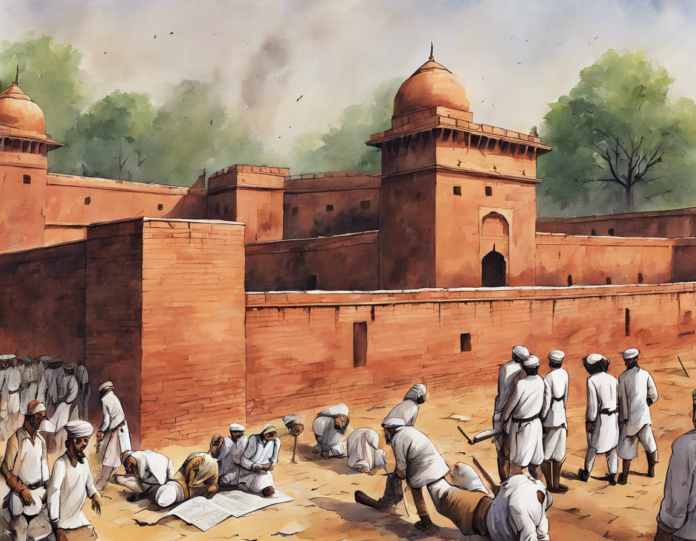On April 13, 1919, one of the most horrific events in Indian history unfolded in the city of Amritsar. The Jallianwala Bagh massacre was a tragic incident that shook the entire nation and left an indelible mark on the struggle for independence from British rule. This ruthless act of violence perpetrated by the British colonial forces against unarmed civilians serves as a grim reminder of the price that was paid for the freedom that India eventually attained in 1947.
Background
The Jallianwala Bagh is a public garden that was enclosed on all sides with only a few narrow entrances, making it an ideal spot for a gathering. On the fateful day of April 13, 1919, thousands of men, women, and children had assembled at the garden to participate in a peaceful protest against the arrest and deportation of two national leaders, Satyapal and Saifuddin Kitchlew. The crowd also gathered to celebrate the festival of Baisakhi, a traditional harvest festival in Punjab.
The Massacre
As the meeting was underway, it is reported that Colonel Reginald Dyer, who was in charge of the British troops in Amritsar, arrived at the scene with his troops and without any warning, ordered his soldiers to open fire on the unarmed crowd. The soldiers, armed with rifles, began firing indiscriminately at the peaceful protesters, trapping them inside the enclosed garden with no way to escape. The firing continued for about 10 to 15 minutes, until the troops ran out of ammunition.
The casualties were devastating. Official figures put the death toll at around 400 people, but other estimates suggest that the number of fatalities could have been much higher, possibly over a thousand. Additionally, around 1,500 people were injured in the bloodbath.
Aftermath
The aftermath of the Jallianwala Bagh massacre was marked by widespread outrage and condemnation, not just in India but across the globe. The incident sparked a wave of protests and strikes throughout the country, as people demanded justice for the innocent lives that were lost. Rabindranath Tagore, the first non-European Nobel laureate in Literature, renounced his knighthood in protest against the massacre.
Despite the public outcry, the British government initially defended Dyer's actions, which further fueled the anger of the Indian populace. It was not until 1920, when the Hunter Commission report was published, that Dyer was relieved of his duties and forced to retire. The report criticized Dyer's actions and held him responsible for the massacre.
Legacy
The Jallianwala Bagh massacre left a deep scar on the Indian psyche and played a significant role in shaping the course of the independence movement. It galvanized the Indian population and fueled their determination to break free from British rule. The incident also highlighted the brutal and oppressive nature of colonial rule, further strengthening the resolve of freedom fighters like Mahatma Gandhi.
In 1951, a memorial was built at the Jallianwala Bagh site to commemorate the martyrs of the massacre. The site serves as a somber reminder of the sacrifice made by those who laid down their lives for the cause of freedom. Every year, on April 13, people from all walks of life gather at the memorial to pay their respects to the victims of the tragedy.
Lessons Learned
The Jallianwala Bagh massacre stands as a stark reminder of the consequences of unchecked power and the importance of upholding the principles of democracy and human rights. It serves as a lesson in history on the perils of using excessive force against unarmed civilians and the need to always strive for justice and equality for all.
Frequently Asked Questions (FAQs)
-
What was the Jallianwala Bagh massacre?
The Jallianwala Bagh massacre was a tragic incident that took place on April 13, 1919, in Amritsar, India, where British troops opened fire on unarmed civilians gathered at a public garden, resulting in hundreds of deaths. -
Who was responsible for the Jallianwala Bagh massacre?
Colonel Reginald Dyer, the British officer in charge of the troops in Amritsar, was directly responsible for ordering the troops to fire on the peaceful protesters. -
How many people were killed in the Jallianwala Bagh massacre?
Official figures put the death toll at around 400, but some estimates suggest that the number of fatalities could have been much higher, possibly over a thousand. -
What was the impact of the Jallianwala Bagh massacre on the Indian independence movement?
The massacre sparked widespread outrage and served as a catalyst for the independence movement, fueling the resolve of Indians to break free from British colonial rule. -
When was the memorial at Jallianwala Bagh built?
The memorial at Jallianwala Bagh was built in 1951 to honor the martyrs of the massacre and serves as a place of remembrance for those who lost their lives on that tragic day.
In conclusion, the Jallianwala Bagh massacre remains a painful chapter in Indian history, reminding us of the sacrifices made by those who fought for the nation's freedom. It serves as a testament to the resilience and spirit of the Indian people in the face of adversity and injustice, and continues to be a symbol of the fight for justice and equality for all.


Recent comments